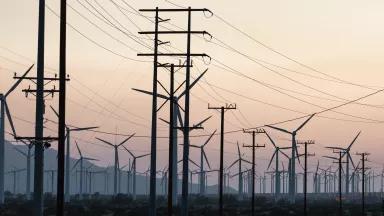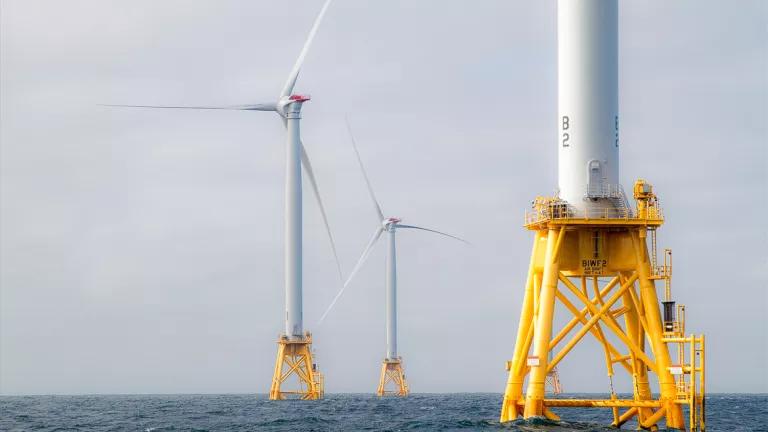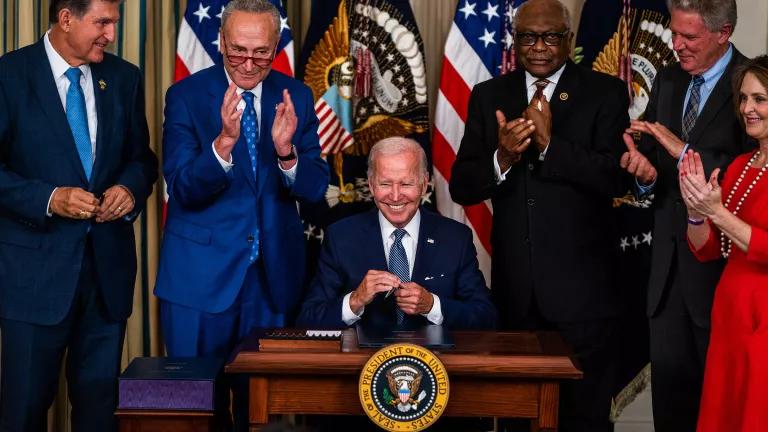How Efficiency Will Help Get Us to Net Zero by 2050
Efficiency will make our transition to a clean energy future cheaper and more cost-effective—and more comfortable, too.

iStock
A transition to carbon-free electricity in the power sector is the most impactful opportunity to cut carbon pollution across a broad swath of the economy. But a new NRDC report, Clean Energy Now for a Safer Climate Future: Pathways to Net Zero in United States by 2050, confirms that power sector investments must be coupled with energy efficiency upgrades to make that transition most affordably and at the pace needed to address the climate crisis. As our buildings, manufacturing, and vehicles switch from polluting fossil fuels to carbon-free electricity, making sure those end uses are as efficient as possible will ensure the power sector—comprised of the power plants, transmission lines, and other electricity infrastructure—is expanded only as needed. By reducing avoidable energy waste, efficiency can help the United States to “right-size” its new clean energy system and avoid the expense of overbuilding new physical energy infrastructure. Ultimately, this helps reduce the costs passed on to American households.
Buildings: Energy efficient for all
U.S. buildings are currently responsible for 26 percent of overall fossil gas use for purposes like heating and water heating, and 74 percent of total retail electricity sales. As the new report outlines, to reach net-zero greenhouse gas emissions by 2050, buildings must rapidly move away from fossil gas, and shift to highly efficient all-electric alternatives while improving building energy efficiency. The good news is that the technologies needed to achieve this transition are well-established and widely available – and funding from the Inflation Reduction Act (IRA) puts an unprecedented amount of investment into building energy improvements.
In NRDC’s Clean Energy Now report, we find that pairing electrification with energy efficiency upgrades can cut over 90 percent of building-related fossil fuel use—and its related emissions— by 2050 compared to today, even as electricity use in buildings falls compared to business-as-usual levels. Smart, efficient building design and retrofits can minimize electricity demand growth and the need for new power plants and grid investments, all while improving comfort and health for building occupants.
The report lays out how we must advance building efficiency: by 2030, all new buildings should be constructed to be net-zero and all new appliances should meet high-efficiency standards. By 2040 at least half of existing buildings should have undergone efficiency retrofits, with that share climbing to 80 percent by 2050. These targets are ambitious, but feasible, especially given the investments for buildings in the IRA – but achieving them will require policymakers at all levels to invest in efficiency.
The energy use of new construction buildings is driven by the requirements of the building energy code. Between the IRA and the Bipartisan Infrastructure Law (BIL), there is more than $1.2 billion available to support state and local governments as they adopt updated energy codes. Jurisdictions must require buildings to be efficient and all-electric as soon as possible, while also incentivizing supporting measures like readiness for electric vehicle charging.
For existing buildings, energy retrofits and high-efficiency, electrified appliances are essential to decarbonization. Whole-house energy retrofits can include improvements to insulation and air sealing, windows, heating and cooling equipment, and appliances. Switching to efficient electric heat pumps for space heating and water heating will be key to reducing energy demand and carbon emissions.
Federal funding in the form of rebates and tax credits for homeowners and business owners to improve the efficiency of their buildings is available (or coming soon) at unprecedented levels thanks to the IRA – but program implementation and guidance to customers to access these funds will be key to success. Likewise, state and local policies like energy efficiency resource standards and utility efficiency programs must be enacted and their ambition strengthened to achieve deep energy efficiency improvements and greenhouse gas reductions. At the same time, federal standards that set the efficiency levels for appliances and equipment must continue to rapidly improve, ensuring that all appliances sold in 2030 are as efficient as the best products available today.
Programs that incentivize building efficiency improvements must be designed to equitably serve low-income and historically disadvantaged communities. Currently, 21 percent of all buildings-related emissions come from the combination of households with an income under 200 percent of the poverty level or commercial buildings in disadvantaged communities. These families and business owners are unlikely to have the resources to invest in improving the efficiency of their buildings, yet they are the ones who suffer the most from high energy burdens, exposure to pollution, and historic underinvestment. Federal, state, and local programs must prioritize investments in energy efficiency and electrification to benefit these communities.
Industrial efficiency: Producing more with less
For the United States to achieve net-zero economy-wide emissions by mid-century, all the modeled scenarios in Clean Energy Now show that industrial sector carbon emissions must fall by roughly one-third below current levels by 2030 and at least 70 percent by 2050. However, the technologies needed to achieve those deeper reductions are not widely available or oftentimes even commercially scaled today. For that reason, our industrial decarbonization strategy has two essential components that must be pursued simultaneously:
- Rapidly deploy existing technologies and measures such as energy efficiency and electrification of low- to medium-temperature industrial processes, in a manner that complements deep decarbonization of the sector. This should be pursued alongside demand reduction measures and better materials recycling.
- Develop and scale new technologies that could transform the carbon-intensive manufacturing processes for products such as cement, steel, and aluminum. For example, carbon capture and storage technologies for the cement industry and the use of green hydrogen to process iron ore into steel in the steel industry.
Fortunately, the BIL and the IRA included billions of dollars for emissions reductions in the industrial sector. Relevant to encouraging efficiency, the IRA includes $250 million in grants to fund the development of Environmental Product Declarations—a best-practice tool for assessing and communicating embodied emissions in industrial products—and $100 million in funding for low-carbon materials labeling. Such efforts to increase the transparency of emissions data will complement federal and state Buy Clean programs to drive greater demand for lower-carbon materials, which should spur manufacturers to pursue energy efficiency and other readily available decarbonization opportunities.
However, more is needed to drive industrial efficiency. NRDC’s modeled scenarios in Clean Energy Now assume incremental energy efficiency gains of 1 percent per year across the entire industrial sector, though there is reason to hope that greater gains are possible: DOE’s Better Plants program with more than 250 partners and 3,500 plants has experienced an average annual energy intensity improvement rate of 2 percent. In addition, EPA’s Energy Star Program certifies plants based on their energy performance and runs a Challenge for Industry competition globally for plants that can achieve more than 10 percent efficiency gains within 5 years. More than 850 plants have participated in the competition, with some concrete plants in the U.S. achieving upwards of 30 percent energy efficiency gains.
The federal and state governments as well as utilities can help to capture these gains. For example, Strategic Energy Management (SEM) is an existing but underutilized approach in which companies can drive sustainable and persistent energy savings by aligning energy efficiency with their business practices and goals. While DOE and some states have promoted SEM and offered technical assistance, the uptake of such programs could be turbo-charged through the creation of incentive programs through utilities and/or the federal and state governments. On top of that, state and utility programs should increasingly focus on industrial efficiency and emissions reductions. NRDC and partners have also called on DOE to move forward with the creation of a Clean Energy Manufacturing Institute to facilitate the thorough and timely decarbonization of industry, with an initial focus on efficient industrial electrification.
Meanwhile, DOE’s Appliance and Equipment Standards Program regulates products that represent approximately 30 percent of industrial energy use and must continue to regularly update the minimum acceptable energy efficiency levels for those categories of industrial equipment. All of these are cost-effective opportunities that can be pursued now to cut pollution, save domestic manufacturers money and enhance their competitiveness in the global market that is increasingly demanding low-carbon industrial materials, and reduce the demands on the electric grid as industrial processes electrify.
Transportation: Making the most of every mile
Dramatic, and much-needed, energy savings in transportation are most readily achieved by switching from inefficient internal combustion engine vehicles to electric vehicles. Vehicles powered by electric motors convert more than 77 percent of their electrical energy to power at their wheels while their gasoline counterparts are only 12-30 percent efficient at turning the energy in their tanks into motion.
As the report highlights, strong federal and state passenger car, truck, and bus pollution standards are critical to ensuring that vehicle manufacturers provide consumers and businesses with plenty of options to choose an electric vehicle instead of a polluting and inefficient combustion engine vehicle.
Energy efficiency remains important as vehicles become electric-powered. More efficient electric vehicles (via high-efficiency motors, better aerodynamics, reduced weight, and other characteristics) can travel a distance using less energy from the electric grid.
Similarly, vehicle power demands can be mitigated if people have alternatives to traveling by personal car. Federal, state, and local governments should focus the BIL to expand and improve public transit and safe routes for walking and biking.
Energy efficiency and electrification go together
Achieving a future of net zero carbon pollution requires the U.S. economy to shift its heavy reliance on fossil fuel combustion to carbon-free electricity. Expanding and deepening decades-long practices of efficient energy use in buildings, industrial processes, and transportation will ensure that each new windmill and solar panel that’s placed in operation serves more Americans with the energy and cleaner air that we all need. That’s American ingenuity at its best.





